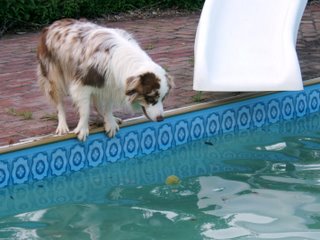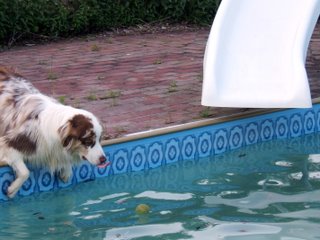POST #6
a - quotes
IRISH HAIKU
Few editors and scholars acknowledge—or are even aware—that the pithy fílíocht now referred to by the Japanese word, Haiku, originated in Galway eleven and a half centuries ago. Scientific legend documents that the terse Irish bards were drawn to short works. Thus, the wee people of the shanties developed ‘tóins’. As is their way the Irish don’t boast about these adornments to world culture.
Norsemen are credited with transporting the traditional Irish tóins to the Japanese home islands. With the luck of the Japanese, they adopted the form, calling the resulting poems Haiku. Over the past century, the content shifted from the characteristic Irish concern for human foibles to the Japanese contemplation of nature and seasonal frailties. Something was lost, or gained, in this transformation. Shakespeare, in the English way, pilfered many Irish tóins and used them in his conceits.
Typical Tóins
The man works
from sun to sun
The woman’s work
is never done.
Beg your pardon
grant your grace
hope the cat will spit
in your face.
The light that lies
in young lads' eyes
and lies and lies
and lies.
Here I am
without a plea
except the clothes that
cover me.
Excuse me she said
as she lept out of bed
‘twas an awkward time
for the excitement.
Thank God for that bite
many a man
woulda called it
a meal.
Horses sweat,
men perspire,
women…
women glow.
A loaf of wine
a jug of bread
beneath ahh...’tis time
for a wee nap.
This selection is taken from the over 421 Irish tóins collected by the twice blessed Margaret Regina Sweeney, a shanty lady who, as a child, was a consultant to the wee people. Sweeney, Irish as Sally’s sow, brashed in where the more polite Japanese declined to enter. No further publication is planned. If you would like to know more about these tóins I suggest you stop a while in Galway.
- - -
b. Continuing my report on Caico:
(see two previous reports on Caico below.)
Saturday Afternoon: Edilma’s cousin Erivan - very friendly and welcoming - drove me around Caicó a couple of hours, described what I was seeing into my halting ears. My eyes can take it in; my ears need a few more years conditioning.

I liked Caicó. How can a community feel relaxed? Don’t exactly know: perhaps because it seems more spacious. Whatever, Caicó is tranquilo.
The main roads here are paved and 4 plus cars wide. In the center city the buildings are mostly well maintained and there is an open-air community plaza with seating and tables for food and beer that probably seats 400 to 500. You have your choice of some twenty surrounding food booths. The plaza is centuries old; a continuation of european patterns and a precursor of shopping-mall food courts.
No high rises! Tallest building I saw was five stories. Some condo buildings. The small wealthy section is easily recognized; large houses set back on plots, with manicured grounds surrounded by free standing walls and fences.
Middle income areas are more diverse. Outside there is little concern for landscaping, while inside these casas can be anything from highly decorated to functional. These small compounds are protected behind walls or iron gates integrated into the structure, as is Maria Rosa’s.
Secondary roads are usually paved with paralelepipedo (a brasilian tongue twister meaning cobblestones as in West Greenwich village in NYC). Side streets, particularly as you move to the edges of town, are hard packed earth.
There is extensive use of speed bumps which literally work wonders to keep the speed down and thereby reduce the number of smashed dogs, cats and people. The need for policemen is also reduced. But, speed bumps raise the need for shops specializing in undercarriage repair.
Erivan drove through two poor areas, favelas, where the roads were narrow and the houses and stores are shabby. Most had no protective gates... but then favelas in Manhattan, Chicago, across the US, across the world tend to be shabby and unprotected.
What is the most popular hat in Caicó? Not a straw for sun protection, not a baseball cap. Motorcycle helmets! The year-round warm weather and relatively low cost make Caicó and surrounds, even more than Natal, perfect for motorcycles (motos); they are everywhere and their drivers are required to wear helmets.
Motos are ridden by all. I saw grandmothers and fathers, women single and some with child, and families with a child or two wedged between the driver and the passenger. There is a service called “moto-taxi”; you simply flag one of the many moto-taxis going by, hop on the back, tuck the child between you and the driver and off you go. Cost; 50 centavos (20 cents) to any place in town. Go shopping, take a moto home holding on to the driver, your packages, your grandmother and your child using both knees and all three hands.
Sunday
The next day Erivan drove Edilma and I along with his daughter and a young friend out to the Sabugi River where a dam made a large swimming hole. As soon as we left the city we were on secondary desert roads of hard packed dirt. These are in good shape but need to be driven with care; 10-15 mph. Walkers, bike riders, and donkeys are softer than cars and move slower.

An occasional deep pothole is best avoided; you will know of it because here someone will certainly have stuck a tree branch in it as a warning. Also it takes a bit of maneuvering crossing cattle guards and over humps built to protect irrigation pipes: everybody out to let the car rise the necessary inch to clear.
Great to watch Erivan, a big man - one of his hands could hold both of mine and have a good grip on my left foot - tending and playing with two small children in the water.
A few other families were there, one of whom had a radio blaring. . . (discouraging echo of the US). A bunch of teenage boys were doing dives and flips off the dam. What else is new?
Edilma and I walked around, talked, laughed and watched. She’s a tad too pregnant to go in swimming, I’m a tad too old for back flips.
Back to Maria Rosa’s for almoço (main meal of the day). Did a little writing and skilfully loafed the afternoon and evening by.
- - -
c. Poems
Two new poems:
RIGHT ON!
Born right, raised right
did everything right
granpop, poppa
granma, mama
right on to Yale
Skulk and Bones
The ayes of Texas
The right gang
- Zaney and Reeve
The righteous have won
MISTER President!
Ooooops!
- - - - - - -
POLI SCI 101
Mentor - Will Rogers
Riding ahead of the herd?
Look back
now and then
make sure it's
still there
In a hole?
Stop digging
Never miss
a chance
to shut up
= = = = = =
Post #5
Introduction
You may have noted that my first Post, a very brief sketch of Brasil, the country, has gone missing; trying to archive it I bumbled. I did this all by myself, and rebooting it into the blog now will be a major hassle so the hell with it.
However it has resurfaced on the "Gringoes" web site. Gringoes is a site for english language speakers here in Brazil and those in the other countries who want to read about and understand Brazil better. It is not perfect, but I guarantee that you will find it presents different, interesting, helpful news and views about my new country. Check it out at: www.gringoes.com.
a) Quotes
“So what do you do for money?”
“I’m on the dole.”
“I thought these days you had to get a job.”
“I’m a poet. There are no jobs for poets.”
“Neffer were, neffer will be,” said Hamish comfortably. “Even Chaucer had a job.”
My song: “Why does no one else understand the happiness and contentment of the truly unambitious man."
Hamish Macbeth/M.C. Beaton
Culture is pruned by commerce’s loud, swift sword.
No one loves me and my hands are cold.
God loves you; you can sit on your hands.
-from the Gaelic
b) Here is a continuation of my report on my visit to Caico. As often, I precede the narrative with a smidgen of background.
Natal (on the ocean) and Caico (in the desert) are in the tropics, some 5° below the equator. The Sabugi River (Caicó) and the South Atlantic Ocean (Natal) make fine swimming holes.
Caicó’s estimated population is 60,000, with the surrounding region (think metro area - in this case desert farms and villages) of about 150,000.

There are some disadvantages to heat and sun: the need by many for sun block and armpit perfume, but many advantages to a tropical climate, including considerable savings: such as no winter clothes, no heating bills, outdoor living.
In Caicó dry heat climbs up over 100° F on a few midsummer days and the best strategy is to do as they do in Phoenix, AZ: avoid going out. In the evening the temperature drops. The rest of the year is comfortably warm.
Notice that when hanging around outside, one reflexively finds shade to stand in, even if it’s only a telephone pole.
Window panes are not necessary since temperatures are usually in the seventies to nineties, though shutters are frequently used for shade and security. Air conditioning is an expensive luxury; when I was living in an apartment in Natal, we did not bother with the air conditioning.
The narrative continues.
We arrived in Caicó about 10pm Friday night. I strung up my rede (hammock) and slept like a baby in Maria Rosa’s - -Edilma’s mother --casa; think a vacation bungalow for six; small, functional, friendly. It is similar to thousands of small casas I’ve seen in Caicó and Natal.
There is an enclosed patio around Maria Rosa’s casa. It is similar to that found around most lower and middle income family houses, equivalent to, but smaller, than a yard. Here children play; folks visit, read, scratch, or sun bathe. The laundry sinks are in the corner of the patio, nearest the kitchen. There may be a washing machine. Dryers aren't needed; the back of the patio is strung with clothes lines.
Maria-Rosa’s casa is a one story building on a packed-dirt side road. It is on an un-landscaped small plot fronted by two small fig trees. There is a red tile roof. It is made of hollow bricks covered with a white cement. The walled-in patio extends half way around the house. In front the wall is replaced by a gated, protective iron-bar fence from ground to roof. It encloses the front porch which has room to park a moto or a small car. It is locked each night.
I have seen similar arrangements in Mexico and other tropical countries where the front porch is part of the living space and needs to be protected from two and four footed marauders. An occasional night time adventure of Caicó teenagers is to throw a firecracker onto a front porch and run. Wish I had thought of that when I was a kid.
Inside there are five small rooms: a living room (sala), two bedrooms, a kitchen, a bathroom and a store room. The small kitchen contains a stove, refrigerator, table and chairs, cabinets; it is similar, albeit more compact, then most kitchens I’ve known, but without the crop of appliances found in wealthier societies.
The furniture is similar to what you’d find in your house, albeit much less of it and much less costly. There is a tv; antennas are perched on house tops across Brazil, as they are across the world. Internet connections are available in service stores in downtown Caicó. The phone of choice is a cell.
A major difference, reflecting the tropic life style, are rede (hammock)hooks built into almost every wall and on the porch.
I slept well in my rede in the living room. I moved it to the patio during the day. The advantages of a rede are low cost, comfort, albeit you get a bit kinked, portability and convenience: at night unroll your rede and hang it on the hooks; position the mosquito netting carefully. In the morning re-roll and stow it on one hook, freeing up the room for other activities.
Caicó does have mosquitos. After the first night, when I woke up having donated blood to a few hundred quiet mosquitos, I slept under mosquito netting. Since these voracious little suckers are night feeders mosquito netting is effective and less expensive than screens. Blankets are not needed.
You get used to cold showers.
Maria Rosa does not have a car. They are expensive to buy and run: gasoline, unlike in the US, is not subsidised and is expensive, think Europe. Caicó is a small city where there is good public transportation and inexpensive moto and automobile taxis. When a car is needed, a neighbour or family member supplies one. And, like in NYC but for different reasons, an occasional public taxi is a better solution than owning and operating your very own private taxi.
Generalization: There is a different living style in Caicó than in “advanced” countries and, increasingly, in Natal. In the latter humans, at great expense, modify the world around them to suit their demands for convenience and comfort. In Caicó people largely adapt to the world around them. Both approaches work and the people in both have the same human capacity to be happy, sad, laugh, cry; whatever, whenever, wherever.
Enough about the casa. What makes a dwelling unique are the people who live in it. The picture below is of Maria Rosa, her grandson Jefferson and granddaughter Beatrice. (My face often gets a reaction like Beatrice’s) I’ll have more to say about them in the future.

c) Poems
CLUMSY
Not well co-ordinated
I often stub my tongue
on words
on sentences
on ideas
even on spinach
and spaghetti
on good days
it trips on
a salty, pouting
nipple
- - -
FOR WHOM THE BELL TOLLED
When Burt Wyman
our Sea Scout Leader
left for Spain
our yawl boat sprung a leak
we didn’t get another leader
our troop fell apart
We no longer patrolled the Palisades
trying to keep walkers on the path
stop people picking flowers
stop big guys from doing it
with girls in the bushes
Burt never came back
from the Lincoln Brigade
disaster at Jarma Valley.
Three years later I joined
the Marines to fight evil
for a while I thought we’d won
- - -
Role Models
Father strode with Jehovah —made
in his image
Mother hugged the Great Spirit
all things to all animals
once a big loser it was staging
a come back.
Uncle Noah enchanted along one of
Buddha’s paths
Aunt Dora worshipped eternal deities
The tooth fairy
Santa Claus
Mammon
= = = =
POST #4 - Flamboyant tree
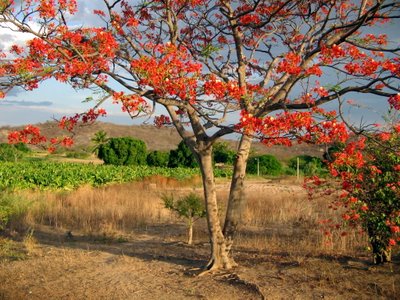
Fotos by Edilma.
a] Odds & Ends
Civilization is a work in progress; it advances by fits and starts.
Thruway Sign: EXIT 54 >>FOOD >> HOSPICE
He smiles all the time. I don’t think he has a central nervous system.
That makes nonsense
“I find it extraordinary that a straight forward if inelegant device for ensuring the survival of the species should involve human beings in such emotional turmoil. Does sex have to be taken so seriously?”
= = = =
b] Report
CAICO #1
(revised)
I recently spent 10 days over Cristmas holiday visiting the family of my friend Edilma in Caicó, a small desert city in the interior of the state of Rio Grande do Norte. I like the family, the city and the surrounding country. I have a fantasy about living there which I am sensible enough not to implement, yet.
The report is divided into digestible segments, this being the first. I will post continuing segments now and again.
- - -
Caicó, RN, Brasil - 1
The Friday before Christmas Edilma and I travelled to Caicó from Natal in a microonibus which seats 14 plus driver and provides door-to-door service - -think a FedX for warm bodies. Crammed with 7 bulky brasileiros, 5 medium sized ones, a skinny americano and one delightful pregnant mother in her 7th month it was cosy.
This was holiday time. Where there was no flesh there was luggage and packages. These were piled five bags high in the aisle, under the seats and on laps up to chins. Very cozy.
All but one young grouch - he was continuously losing a video game on an ipod - were in a holiday mood chattering and laughing. Edilma sang along to some gentle, brasileiro music by Ramalhos & Azevedo.
The trip, my eleventh outside Natal, my first into the interior took four hours. The highway was a long winding road, one lane in each direction with considerable holiday traffic. We passed through four or five small cities and a few dusty villages. Now and then a hard packed dirt road wandered off into the desert scrub.

The country side gradually changed from littoral tropical green to desert; rocky and sandy, brown with a scattering of green from cactus, mesquite trees and irrigated crop lands- -think southern Arizona. On the way to Caicó I saw signs for a few “fazendas”- large farms - but the fazenda buildings were well off the highway and I saw nothing but privacy.
It grew dark as we drew near Caicó. Suddenly the lights of the city sparkled into view from some 5 miles across the desert. Beautiful.
Look up! Stars!! Millions of them. It was as if they were reflecting and multiplying the lights of Caicó. Wonderful, particularly since you see few stars in brightly lit Natal. The southern cross is up there, somewhere.
= = = =
c] Poems
At 2:10am
a bike rider
meandered slowly
past sleepy
Natal Central Hospital
whistling
gently
- - - - -
THANKS FOR ASKING
I am good.
Operation was successful
I hope to be walking soon
Mercedes was totaled but
The wife and the kids are okay
...got all the toys money can buy.
Tell me again
what were those things
money can’t buy?
- - - - -
My poetry web site is: www.halsutcliffe.org
= = = =
FELIZ ANO NOVA!!
Post #3
27 November 2006
Natal works for me. Benign weather, mostly friendly people, making new friends. I am relaxed, not pressuring myself to perform.
There is new material in the first three sections. Take a moment, leave a comment; just click on the word "comment" at the end of this post and follow your nose.
3a) Odds & Ends
Poems are songs for people with bad singing voices.
There but for the grace of god, goes god. (think Bush)
Love might provoke kindness, gratify vanity, and clear the skin, but it is not guaranteed to be the high road to happiness.
The world's richest 500 individuals have the same income as the world's poorest 416 million people.
---
3b) Sketches
My first two posts sketched the bare bones of Natal. These will be fleshed out over the next twenty or thirty years with intermittent descriptions of specific activities that have caught my attention. For example: traffic.
Natal is blessed with a major status symbol of our 21st century: cars and rush hour traffic. In addition, motorcycles (motos) are big here.
The favorite rush hour sport among those with snappy new cars cars is street racing. A challenge is offered by a driver waiting at a red light who guns his engine a few times (translated: I will beat you to the next red light!). If the the driver beside him responds by gunning his/her engine, the challenge is accepted. Other driver's become an endangered species.
GREEN LIGHT! Engines roaring they rip down the block, screeeech to a halt at the next red light. There they re-rev their horses, tires pawing the street. When the light turns green they re-roar down the road engines screaming, tires scorching, so that they can wait at the next red light. Some of them even try to race my antique Fiat. As in the US, many of the macho/macha drivers also bob and weave, tires kicking sand in your face, to the next red light simply because it's there.
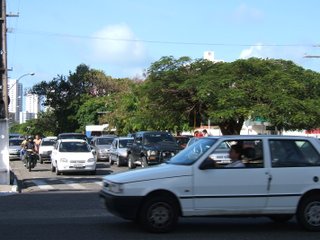
More interesting are the motos. Thanks to the benign year around weather motos are everywhere; in your rear view mirror, in the side mirrors and up-your nose. They are manoeuvred by helmeted men, boys, women, girls. These are commuting and/or or working machines used to deliver spouses to work and deliver stuff ranging from love seats (takes a bit of skill) and LPG tanks to water bottles and take-out lunches. This morning I saw a Harley with two milk crates full of clucking chickens piled one-top-the other. I'd be clucking too.
My recent memory of the US is that nowadays a very large percentage of motorcycles are used for recreation. They are driven by sedate paunchies, usually in groups which used to be called gangs. But in Natal moto jockeys are individuals, with only an occasional pair in tandem.
Friend Fabiane, recently bought a Yamaha...here’s a picture of her about to give her aunt a ride. Fabiane is a member in good standing of the Policia Militara(State Police).

The only analogy that comes to mind about the motos amazing progress through the obstacle course of bulky automobiles is the trick horseback riding that awes you at a rodeo. They slip through traffic and at red lights they slither through jammed cars to the front of the pack, accelerate to freedom a split second before the green shows. It takes me half an hour to get from Nova Parnamirim to Tirol in rush hour, these trick riders make it in five, eight minutes at the outside. The macho car drivers don’t stand a chance against a skilled moto operator.

My contribution to this chaos is modest: I own a scratched and dented, 1996 royal blue Fiat. No power steering, no air conditioning, no radio. It runs, thank you, like a well wound grandfather’s clock. It shouts out to car thieves, “Not this one, it’s a mess, worth nothing.” I think it gorgeous, even though I lose every race.
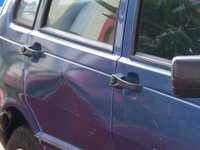
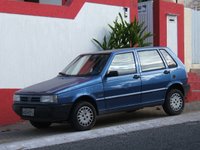
- - -
3c) poetry
Here are two short poems of mine. Grandfather my first published poem, fifteen years ago.
Grandfather drank
to dead Celts
Mother knew God
would cure her cancer
Father saluted the flag
on his coffin
Feed my corpse
to hungry crows
- - - - - - - - - -
Akiko
Tonight just now
my body bowed
to the god
within a petite
Japanese woman
who is taller
than she stands
- - - - - - - - -
No foto essay this time.
POST #2
22 October 2006
The handsome dog in the foto vignette at the end of this Post is an Australian something or other. He belongs to the children of my daughter Amy. He is smart enough to know that if he jumps in after the ball it will skitter away. He who waits and wades often wins!
2a) ODDS & ENDS
I would be caught dead jogging.
Why is it that whatever hits the fan will not be evenly distributed?
Uncharacteristically, he jumped to his death.
Guantanamo Bay - Trial and Terror
- - -
2 b) RIO GRANDE do NORTE (RN)
Natal (christmas in portugues), now the capital and the largest city in the state of RN, was one of the first European settlements in the northeast. The village which grew to be our city, was established December 25th, 1599. It is on the South Atlantic at the mouth of the Potengi river. On your map you will find it on the big hump on the northeast coast of Brasil closest to Africa. We are about 5° below the equator.
French pirates ‘occupied' Natal in the 1590’s. They "traded" with the native Portiguars - a name which is still used to characterize folks born here.
The French were driven out by the portugues in 1597 leaving no traces. The still standing Forte dos Reis Magos (named after the biblical three wise kings) was built in 1598-99 to guard the harbor and mouth of the river. I think it the most interesting historic site in Natal.

Later the Dutch occupied the village and the fort for a few decades before they too were shoved out by the Portugues. Many of the dutch settlers fled inland and are said to be the reason some of todays inland brasileiros have green eyes, fair skin and wonderful smiles.
The major economic activity in RN in the first three hundred years was cattle raising in large “fazendas” (ranches) in the desert country in the interior. From this ‘crop’ came ‘jerked beef’ here called carne de sol. I think the cattle walk hundreds of kilometers to the slaughter house which gives the meat its tough, jerky consistency . . . good though!
In the 18th century salt became a major crop; large ponds were flooded with ocean water at high tide, then allowed to dry out in the hot sun; the residual salt was ‘harvested’. This is a traditional, world-wide salt farming method: I’ve seen remainders of similar ponds in Provincetown on Cape Cod.
Petroleum became a major "crop" in the 19th century. RN has Brasil’s largest inland reserves of 'oleo'. Today, the coastal waters of the South Atlantic off Brasil are the major source of petroleum. Using a combination of oleo, alcool (gasoline, alcohol) and stiff prices, Brasil has become self-sufficient in automotive fuel. Other important crops in RN are fishing and shrimp farming.
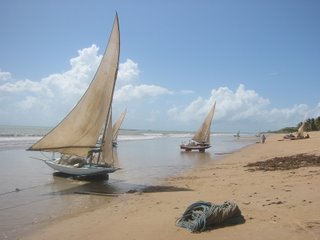
Fishing Boats - Foto by Mike
During World War II the US built a major airport here which was manned by a few thousand American soldiers. It was used as a ferrying station: Florida <> Natal <> Africa <> Europe. Many of the soldiers married brasileiras; some remained in Brasil, others took their new wives to stateside. There are pictures of President Roosvelt in Natal on his way to and fro from a World War II conference in Europe. Today it is Natal’s modern, Augusto Severo Aeroporto.
Natal - Cidade de Sol - welcomes about 2,000,000 tourists to its shores every year. The delightful, year around climate and 250 kilometers of adjacent ocean beaches are the major attraction. Wind surfing is consistently good and it is the world center of Dune Buggy rides or, if you are choosy, you can lurch around on a camel. Offshore, the island of Fernando de Noronha is one of the world's finest locations for underwater diving. Eco Tourism is growing; despite cuttings, the northeast has by far the largest tropical forest in the world.
Sorry, but the weather here is near perfect. Ten minute rain showers come and go now and again but a hard days rain rarely falls; maybe three or four isolated days in the winter (July, August, September) . Reported research verifies that the air quality here is the best of any major city in the world. My emphysema-blessed lungs think it is fun to breath.

The temperature ranges between 75° and 95°. Onshore breezes from the South Atlantic sharply reduce the humidity; nope, no hurricanes. Inland the northeast of Brasil is desert - think Arizona. Here on the littoral there are fine beaches in a people friendly city; not perfect, but aside from Soggytrees, N.Y. what city is?
The city has about 800,000 people, the majority earn a low-minimum wage, or less; a middle class that is growing, slowly, and a small number of rich who, as is their wont, manage. While this overall pattern is similar to those in the US, Europe and elsewhere, there are proportionately more poor here and the middle class is smaller.
Folks from Europe tourist in Natal and buy vacation condos; some retire here. Brasilian tourists come up from Rio de Janeiro to avoid mobs of foreign tourists. There are few americanos, largely because they tend to dead-end in Mexico or the Caribbean Islands. The latter are a lot closer to home and the resorts there cater to the americano preference for americanos.
2c) POEMS
One of the worlds great poets is Wistawa Szymborska, winner of the Noble Prize for Literature in 1996. Robert Hass, fine American poet, observed, “She is unquestionably one of the greatest living European poets. She’s accessible and deeply humane and a joy––though it is a dark kind of joy." I admire her work immensly.
THE END AND THE BEGINNING
After every war
someone has to tidy up.
Things won’t pick
themselves up, after all.
Someone has to shove
the rubble to the roadsides
so the carts loaded with corpses
can get by.
Someone has to trudge
through sludge and ashes,
through the sofa springs,
the shards of glass,
the bloody rags.
Someone has to lug the post
to prop the wall,
someone has to glaze the window,
set the door in its frame.
No sound bites, no photo opportunities,
and it takes years.
All the cameras have gone
to other wars.
The bridges need to be rebuilt,
the railroad stations, too.
Shirtsleeves will be rolled
to shreds.
Someone, broom in hand,
still remembers how it was.
Someone else listens, nodding
his unshattered head.
But others are bound to be bustling nearby
who’ll find all that
a little boring.
From time to time someone still must
dig up a rusted argument
from underneath a bush
and haul it off to the dump.
Those who knew
what this was all about
must make way for those
who know little.
And less than that.
And at last nothing less than nothing.
Someone has to lie there
in the grass that covers up
the causes and effect
with a cornstalk in his teeth,
gawking at clouds.
- - -
Check your library: Wistawa Szymborska, Poems New and Collected
= = =
2d) FOTO VIGNETTE
"I want that ball!"
